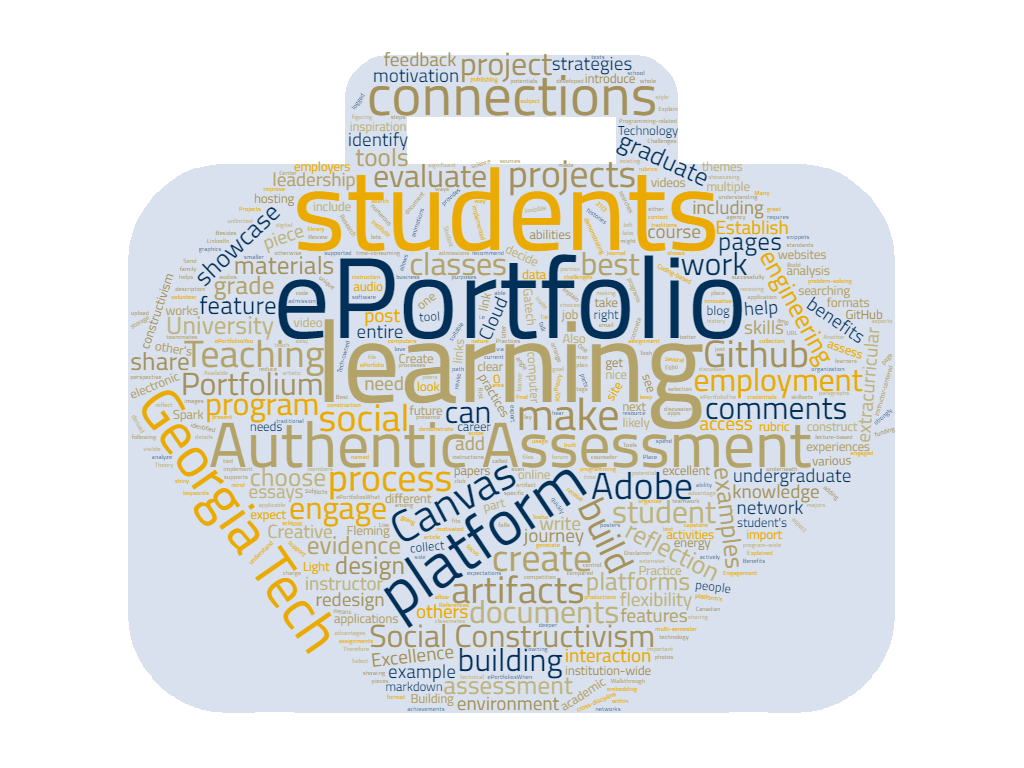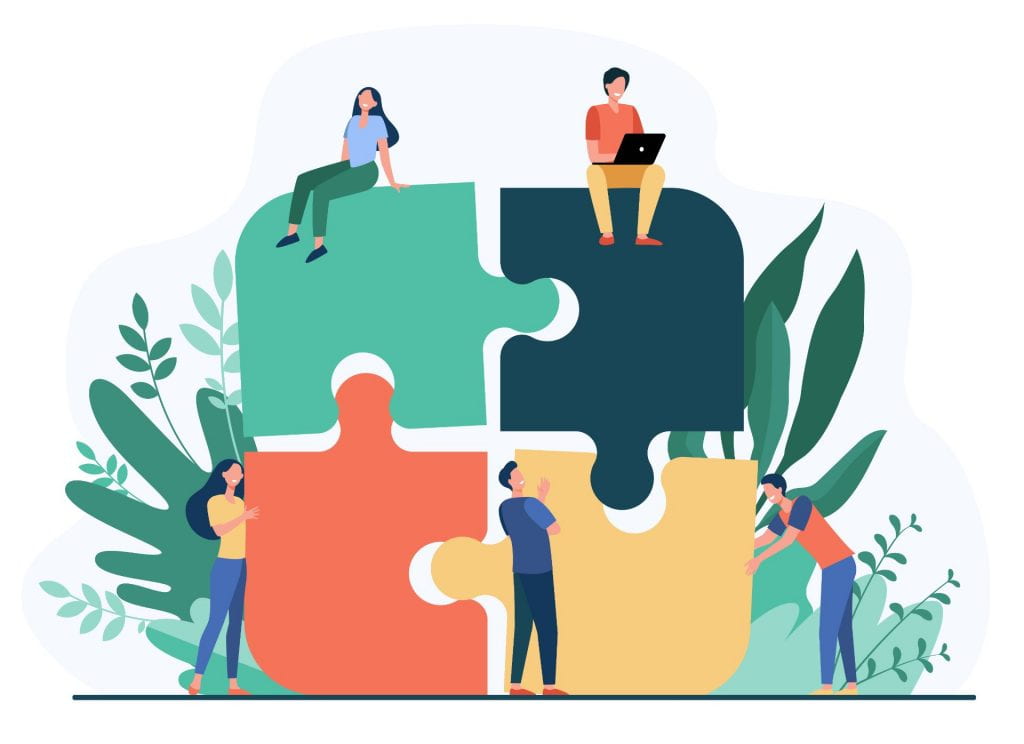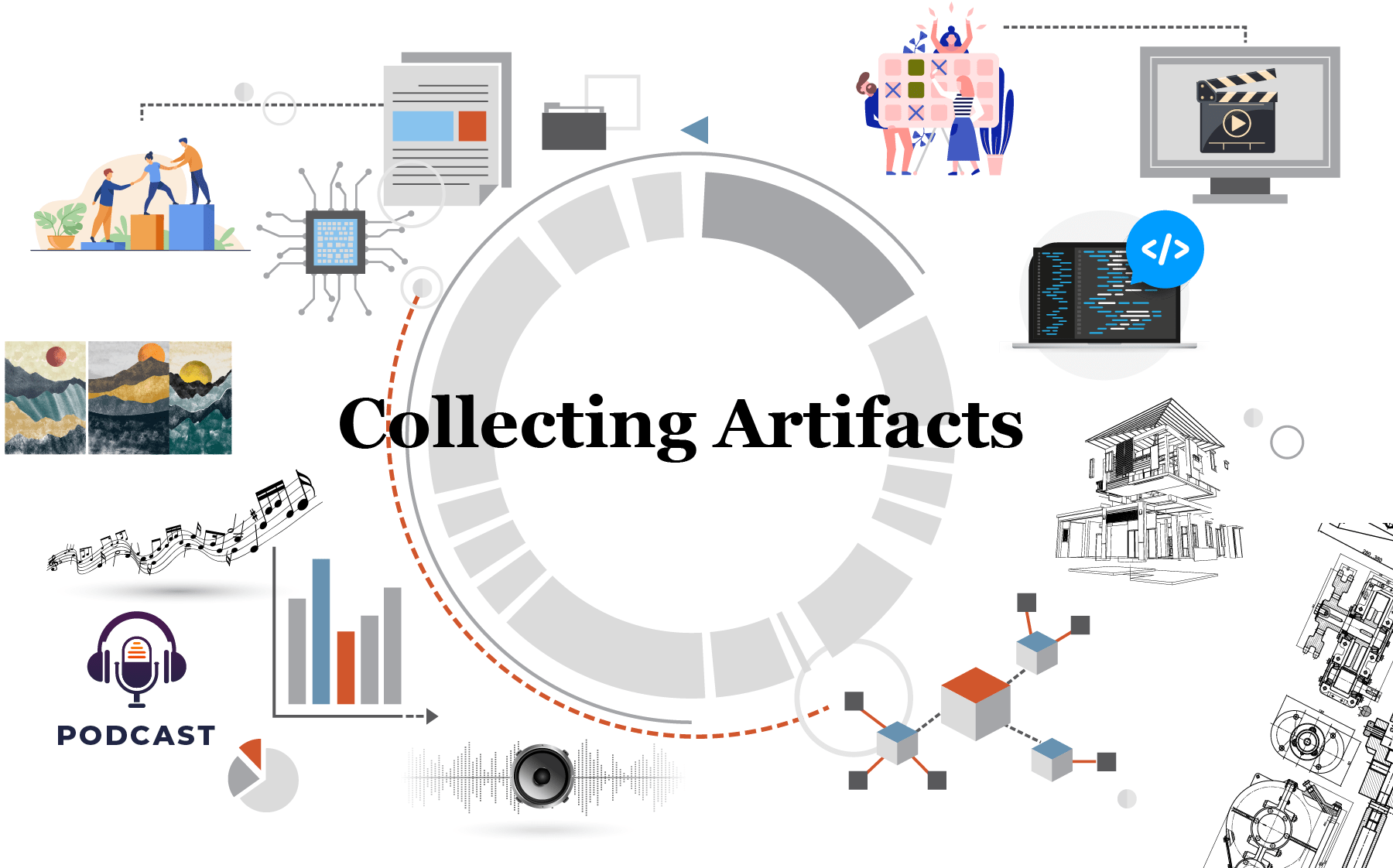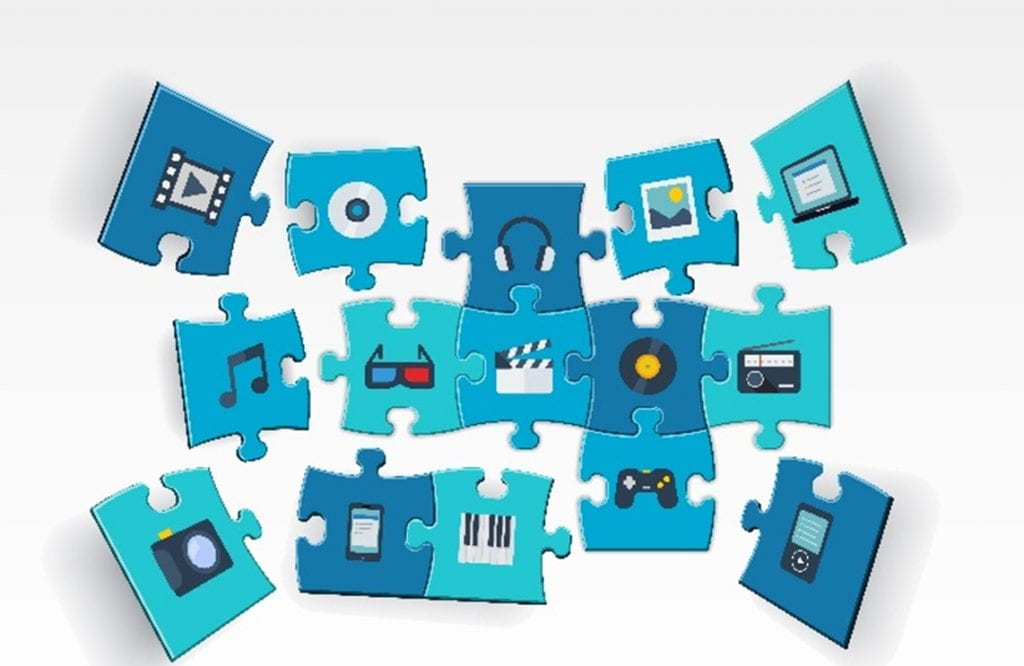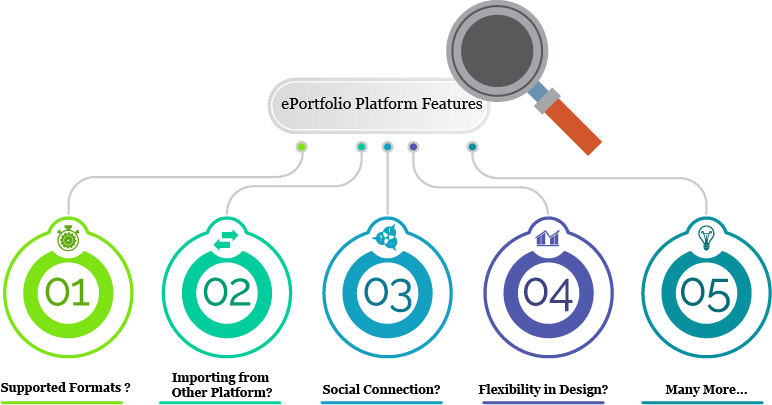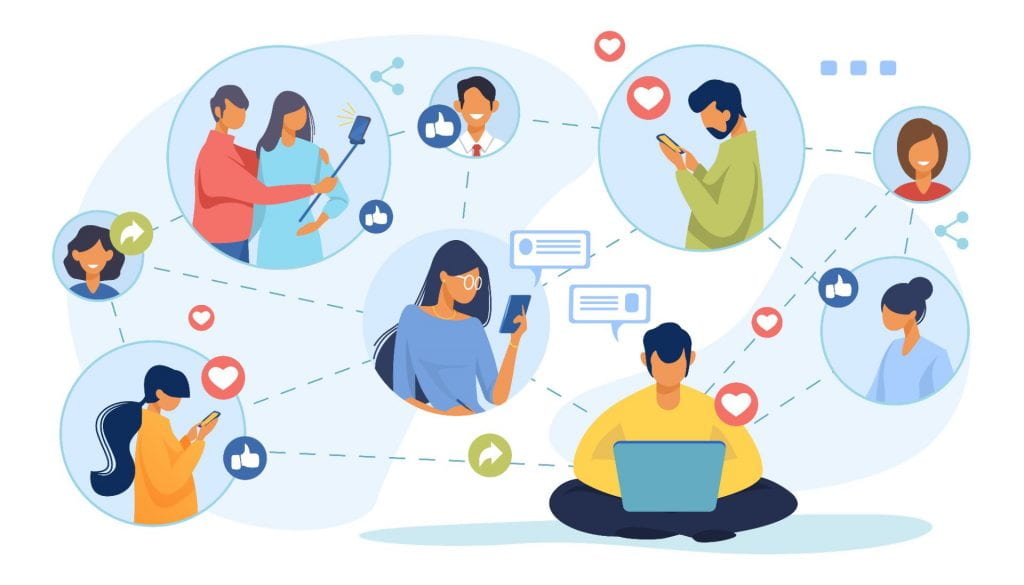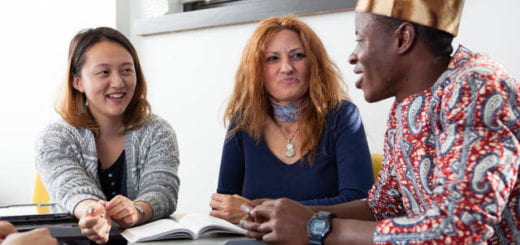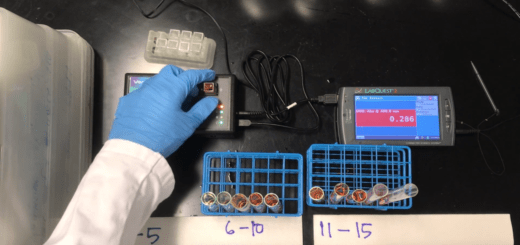Supporting Students’ Learning with ePortfolios
What is ePortfolio?
An ePortfolio in the academic context is a digital or online collection of students’ coursework, such as essays, posters, technical papers, videos, and audio productions. It can also include the student’s employment and volunteer history, club activities, and more. A good student ePortfolio should not only document learning but also generate learning.
Many programs at Georgia Tech have traditions to use electronic portfolios for various purposes, such as undergraduate admissions and graduate program admission, student work showcase, and competition.
Benefits of Using ePortfolios for Students Learning
Research shows many benefits of using ePortfolios for students learning, such as
- Supporting students’ knowledge construction (Lewis, 2017; Rico, 2017)
- Engaging students in the learning process (Fuller, 2017)
- Motivating students to create evidence for future career advancement (Perks & Galantino, 2013)
We will discuss each aspect next.
Supporting Students’ Knowledge Construction
The process of building an ePorfolio itself is a process for a learner to construct learning. This process falls under a learning theory called Social Constructivism (Amineh & Asl, 2015). Social constructivism is a process where learners construct their knowledge through interaction with the learning materials, learning environment, and people compared to the traditional instructor-centered, lecture-based learning style.
When students build an ePortfolio, they first collect the materials, such as their course works, papers, extracurricular activities, and employment histories. During this process, they revisit their past learning materials, recall what they have done in the past, and make decisions on which materials can be included in their ePortfolios. There are no limitations on the format of the artifacts that can be included. No matter if it is a written essay, a PowerPoint presentation, photos, graphics, recorded music, a film, an animated video, a piece of code, an architecture design, a design of machinery… As long as the artifact demonstrates students’ knowledge and skills, it can be included in their ePortfolios.
Students will then evaluate each piece of the work, decide how each part fits with others, make connections, and find one or several themes. In this process, students perform further analysis of their past work and find the connection between each coursework or project. They now have the opportunity to connect the dots and see the whole picture. Students will compare their own works work over time and obtain a deeper understanding of how their previous knowledge and skills helped to build the later ones.
In order to decide how to organize their materials best, students will also need to understand the ePortfolio platform’s features. Does the platform allow the students to add pages and edit navigation? Can students edit the look and feel of the pages? What formats of media are supported by the platform, in what way? Can I embed those media files, or do I have to upload them as attachments? A well-designed ePortfolio will fully utilize features of the selected platform to the maximum extent to demonstrate the students’ artifacts. On the other side, students should be encouraged to get creative when the platform can’t provide a certain feature.
For all the steps mentioned above, visiting their peers’ ePortfolios is always the best way to get ideas and inspirations. For example, by reading other students’ reflections, students may make connections to their own experiences. They may rediscover the learning that happened during their projects or discover new knowledge from their peers. By browsing their peer’s ePortfolios, students can borrow ideas from their peers on how to organize the materials, how to present their artifacts, how to design the pages,
All these learning and reflection happen in the process of selecting artifacts, making connections, and presenting the artifacts. A good ePortfolio will include not only just projects or artifacts but also written paragraphs of reflections on the artifacts. Students will learn to use the projects and artifacts to tell their stories of learning. They will describe each piece and the learning that occurred when working on these pieces. When students write their reflection in texts, they have to transform their opinions in mind into language, they, therefore, need to summarize not only what they have learned, but also how they have learned, which will benefit their future learning.
Students can then share their ePortfolios with their classmates, the instructor, program counselor, potential employers, or family members. The benefits of receiving feedback are similar to the process of visiting peers’ ePortfolios but in a more interactive and active way. Feedback can be about a question about a certain content of the ePortfolio, or some suggestions to improve the user experience of viewing the ePortfolio, or it could be simply some applause for the great work.
Engaging students in the learning process
Students building and owning the ePortfolio means that they are in control, and they are more likely to engage in the learning process actively. Research shows that students are more engaged when they have choices in learning (Tosha, Penny Light, Fleming, Haywood, 2005). Students are to use ePortfolios to map out their learning and career path because:
“…the very process of developing an ePortfolio prompts students to adopt future-oriented thinking.” (Bennett, Rowley, Dunbar-Hall, Hitchcock, & Blom, 2016)
Motivating students to create evidence of learning for future career advancement
In addition, many students may plan to use their ePortfolios for their job searches, funding, and graduate school program applications. With a future application goal in mind, students are more motivated to create artifacts and pieces of evidence to highlight their knowledge and skills, problem-solving ability, and leadership.
Contact Us
In the next blog post about ePortfolios, we will discuss the Best Practices and Strategies of Using ePortfolios to Support Student Learning. Following that, we will discuss a few tools and platforms for Georgia Tech students to build ePortfolios. If you are an instructor and have successfully used ePortfolio for your project, we would love to hear from you. Send an email to rui.hu@gatech.edu, and we might be able to feature your innovative usage in a future post.
References
Amineh, R.J., & Asl, H.D. (2015). Review of Constructivism and Social Constructivism. Journal of Social Sciences, Literature, and Languages, 1, 9-16.
Bennett, D., Rowley, J., Dunbar-Hall, P., Hitchcock, M., & Blom, D. (2016). Electronic portfolios and learner identity: An ePortfolio case study in music and writing. Journal of Further and Higher Education, 40(1), 107- 124. doi:10.1080/0309877X.2014.895306
ePortfolios Explained: Theory and Practice. Centre for Teaching Excellence, University of Waterloo.
Fuller, K. (2017). Beyond Reflection: Using ePortfolios for Formative Assessment to Improve Student Engagement in Non-Majors Introductory Science. The American Biology Teacher, 79(6), 442–449. https://doi.org/10.1525/abt.2017.79.6.442
J.M. Perks, & M. Galantino. The development of an ePortfolio as a capstone in a holistic health minor. International Journal of ePortfolio, 3 (1) (2013), pp. 39-46.
Lewis, L. (2017). ePortfolio as pedagogy: Threshold concepts for curriculum design. E-Learning and Digital Media, 14(1-2), 72–85. https://doi.org/10.1177/2042753017694497
Rico, C. (2017). The ePortfolio: constructing learning in translation technology. The Interpreter and Translator Trainer, 11(1), 79-95. https://doi.org/10.1080/1750399X.2017.1306995
Tosh, D., Penny Light, T., Fleming, K., & Haywood, J. (2005). Engagement with electronic portfolios: Challenges from the student perspective. Canadian Journal of Learning and Technology, 31(3).
Acknowledgment:
![]() This blog post is derived from the work of the Centre for Teaching Excellence, University of Waterloo, by the Center for Teaching and Learning at the Georgia Institute of Technology.
This blog post is derived from the work of the Centre for Teaching Excellence, University of Waterloo, by the Center for Teaching and Learning at the Georgia Institute of Technology.

